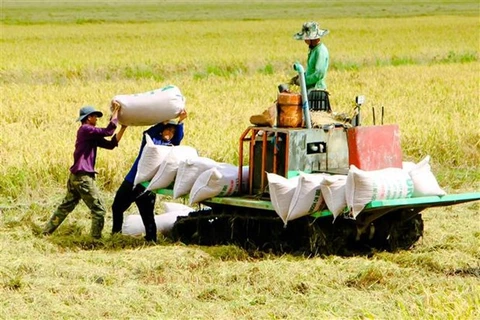Hanoi (VNA) – Vietnam raked in 25.08 billion USD from exports in January 2023, down 13.6% from the previous month, according to the Ministry of Industry and Trade (MoIT).
The ministry reported that the total import-export turnover reached 46.56 billion USD, down 17.3% from the previous month and 25% year on year, with imports falling 28.9% to 21.48 billion USD.
Key exports witness dropping turnover
According to the ministry, the processing and manufacturing industry is no longer the driver of growth as its export turnover has experienced the sharpest decline in the month.
The processing industry earned over 21.52 billion USD, down 21.7% compared to the same period last year.
The result is attributable to the long New Year and Lunar New Year (Tet) holidays, which were all in January, reducing the number of working days.
Meanwhile, the export of agricultural – forestry, and fuel and mineral products reached an estimated 2.14 billion USD and 245 million USD, respectively dropping 19.8% and 9.7% year-on-year.
The US remained the biggest importer of Vietnamese goods with a revenue of about 7.6 billion USD (down 28.5%), followed by China with 4.45 billion USD (up 14%); the European Union (EU), 2.9 billion USD (down 33.8%); Japan, 1.8 billion USD (down 11.4%); and the Republic of Korea (RoK), 1.65 billion USD (down 18.4%).
However, there were seven groups of exports of over 1 billion USD, including phones and components; electronics, computers, and components; machinery, equipment, and other spare parts; textiles, garments, and footwear; wood and wooden products; and transport vehicles and spare parts. Their export value accounted for 66.6% of the country’s total.
Meanwhile, the imports fell 28.9% year-on-year to 21.48 billion USD in the reviewed period.
Despite a sharp decline in exports to key markets, the country still enjoyed a trade surplus of 3.6 billion USD last month.
Stepping up trade promotion activities
According to the MoIT, one of the major factors impacting Vietnam's exports is the decreasing global demand for commodities in areas where Vietnam is strong.
The ministry attributed the situation to the ongoing global economic downturn, particularly in those which are main import markets of Vietnam such as the US, the EU, and Japan.
Furthermore, supply chain disruptions have led to significant increases in raw material prices, resulting in higher production costs and reducing competitiveness of Vietnamese goods, it said.
High inflation and inventory levels in many countries have also affected the import demand, particularly non-essential items which are Vietnam's key exports such as textiles, garments, and footwear products, it added.
The decline in global demand is indeed a challenge for Vietnam's export growth in 2023, said a representative from the MoIT.
Deputy Minister of Industry and Trade Do Thang Hai said if free trade agreements (FTAs) signed between Vietnam and its partners are effectively leveraged, Vietnam can further export its products.
Additionally, domestic and foreign investment attraction can also create motivation to promote production for exports, he added.
The MoIT pledged to continue coordinating with localities and the Ministry of Agriculture and Rural Development to guide exporters in completing procedures for the official export of agricultural and aquatic products to China in order to fully tap export opportunities to the market.
The ministry will also focus on speeding up the application of information technology and digital transformation in trade promotion activities to help Vietnamese businesses save costs and improve trade promotion efficiency in the near future, Hai said./.


























